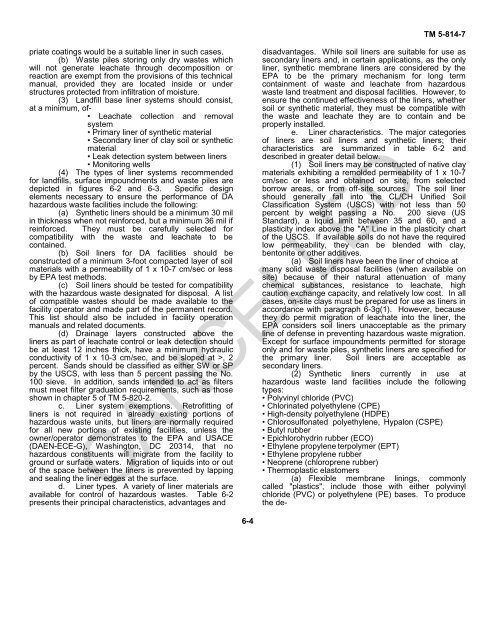UFC 3-280-02A Hazardous Waste Land Disposal/Land Treatment ...
UFC 3-280-02A Hazardous Waste Land Disposal/Land Treatment ...
UFC 3-280-02A Hazardous Waste Land Disposal/Land Treatment ...
Create successful ePaper yourself
Turn your PDF publications into a flip-book with our unique Google optimized e-Paper software.
priate coatings would be a suitable liner in such cases.(b) <strong>Waste</strong> piles storing only dry wastes whichwill not generate leachate through decomposition orreaction are exempt from the provisions of this technicalmanual, provided they are located inside or understructures protected from infiltration of moisture.(3) <strong>Land</strong>fill base liner systems should consist,at a minimum, of-• Leachate collection and removalsystem• Primary liner of synthetic material• Secondary liner of clay soil or syntheticmaterial• Leak detection system between liners• Monitoring wells(4) The types of liner systems recommendedfor landfills, surface impoundments and waste piles aredepicted in figures 6-2 and 6-3. Specific designelements necessary to ensure the performance of DAhazardous waste facilities include the following:(a) Synthetic liners should be a minimum 30 milin thickness when not reinforced, but a minimum 36 mil ifreinforced. They must be carefully selected forcompatibility with the waste and leachate to becontained.(b) Soil liners for DA facilities should beconstructed of a minimum 3-foot compacted layer of soilmaterials with a permeability of 1 x 10-7 cm/sec or lessby EPA test methods.(c) Soil liners should be tested for compatibilitywith the hazardous waste designated for disposal. A listof compatible wastes should be made available to thefacility operator and made part of the permanent record.This list should also be included in facility operationmanuals and related documents.(d) Drainage layers constructed above theliners as part of leachate control or leak detection shouldbe at least 12 inches thick, have a minimum hydraulicconductivity of 1 x 10-3 cm/sec, and be sloped at >, 2percent. Sands should be classified as either SW or SPby the USCS, with less than 5 percent passing the No.100 sieve. In addition, sands intended to act as filtersmust meet filter graduation requirements, such as thoseshown in chapter 5 of TM 5-820-2.c. Liner system exemptions. Retrofitting ofliners is not required in already existing portions ofhazardous waste units, but liners are normally requiredfor all new portions of existing facilities, unless theowner/operator demonstrates to the EPA and USACE(DAEN-ECE-G), Washington, DC 20314, that nohazardous constituents will migrate from the facility toground or surface waters. Migration of liquids into or outof the space between the liners is prevented by lappingand sealing the liner edges at the surface.d. Liner types. A variety of liner materials areavailable for control of hazardous wastes. Table 6-2presents their principal characteristics, advantages andTM 5-814-7disadvantages. While soil liners are suitable for use assecondary liners and, in certain applications, as the onlyliner, synthetic membrane liners are considered by theEPA to be the primary mechanism for long termcontainment of waste and leachate from hazardouswaste land treatment and disposal facilities. However, toensure the continued effectiveness of the liners, whethersoil or synthetic material, they must be compatible withthe waste and leachate they are to contain and beproperly installed.e. Liner characteristics. The major categoriesof liners are soil liners and synthetic liners; theircharacteristics are summarized in table 6-2 anddescribed in greater detail below.(1) Soil liners may be constructed of native claymaterials exhibiting a remolded permeability of 1 x 10-7cm/sec or less and obtained on site, from selectedborrow areas, or from off-site sources. The soil linershould generally fall into the CL/CH Unified SoilClassification System (USCS) with not less than 50percent by weight passing a No. 200 sieve (USStandard), a liquid limit between 35 and 60, and aplasticity index above the "A" Line in the plasticity chartof the USCS. If available soils do not have the requiredlow permeability, they can be blended with clay,bentonite or other additives.(a) Soil liners have been the liner of choice atmany solid waste disposal facilities (when available onsite) because of their natural attenuation of manychemical substances, resistance to leachate, highcaution exchange capacity, and relatively low cost. In allcases, on-site clays must be prepared for use as liners inaccordance with paragraph 6-3g(1). However, becausethey do permit migration of leachate into the liner, theEPA considers soil liners unacceptable as the primaryline of defense in preventing hazardous waste migration.Except for surface impoundments permitted for storageonly and for waste piles, synthetic liners are specified forthe primary liner. Soil liners are acceptable assecondary liners.(2) Synthetic liners currently in use athazardous waste land facilities include the followingtypes:• Polyvinyl chloride (PVC)• Chlorinated polyethylene (CPE)• High-density polyethylene (HDPE)• Chlorosulfonated polyethylene, Hypalon (CSPE)• Butyl rubber• Epichlorohydrin rubber (ECO)• Ethylene propylene terpolymer (EPT)• Ethylene propylene rubber• Neoprene (chloroprene rubber)• Thermoplastic elastomers(a) Flexible membrane linings, commonlycalled "plastics", include those with either polyvinylCANCELLED6-4chloride (PVC) or polyethylene (PE) bases. To producethe de-
















